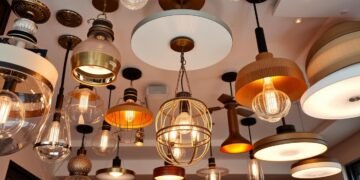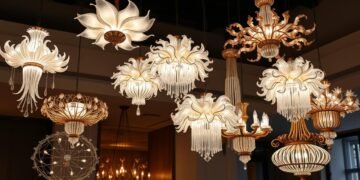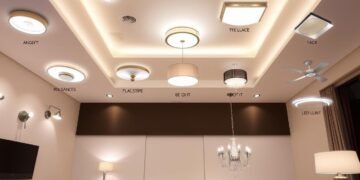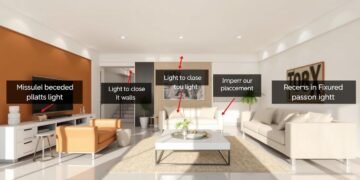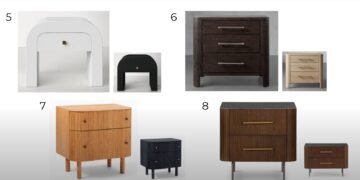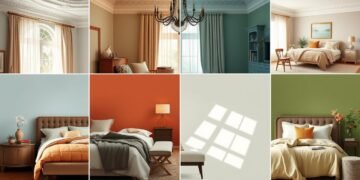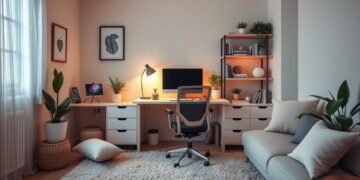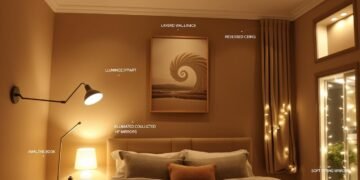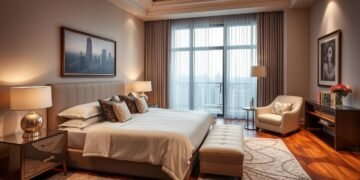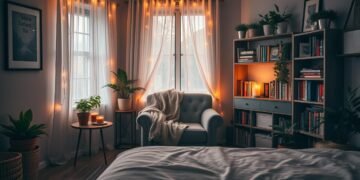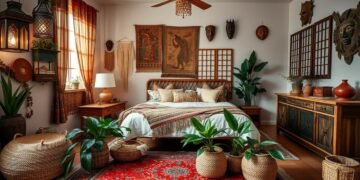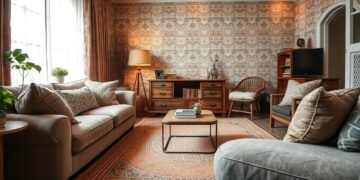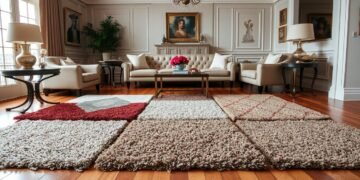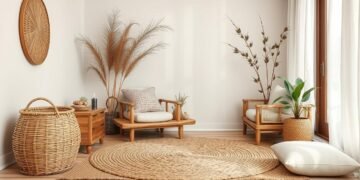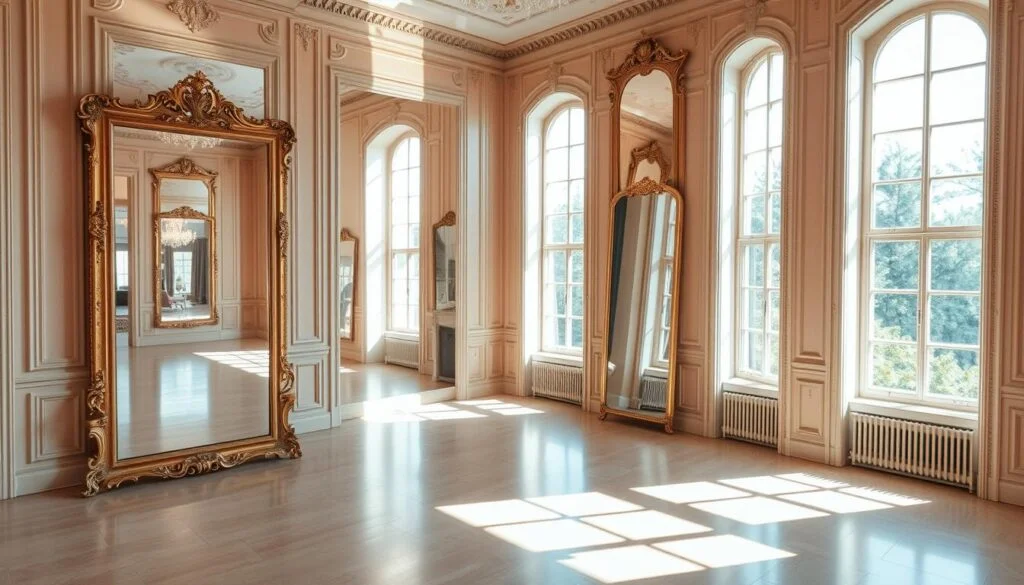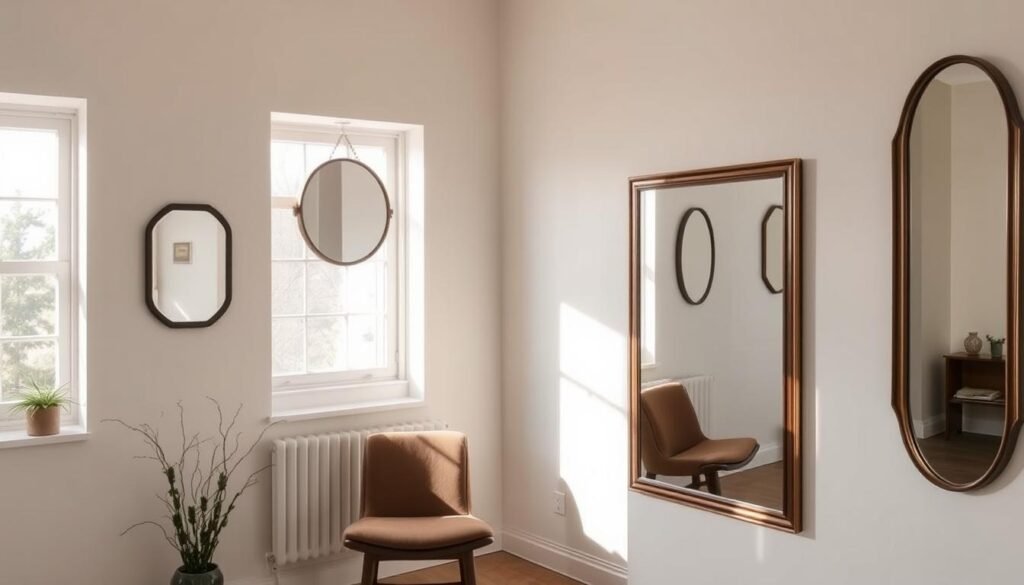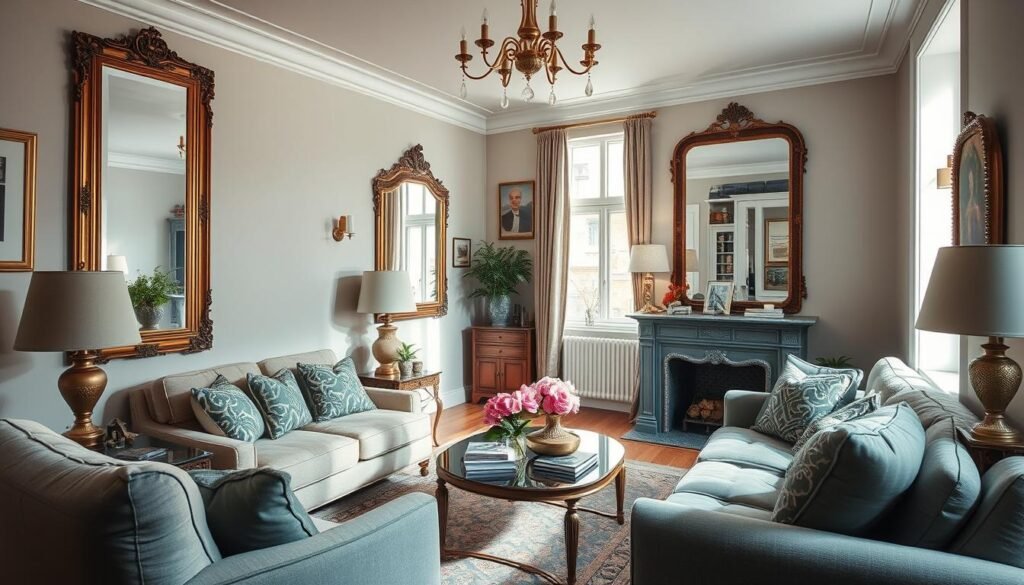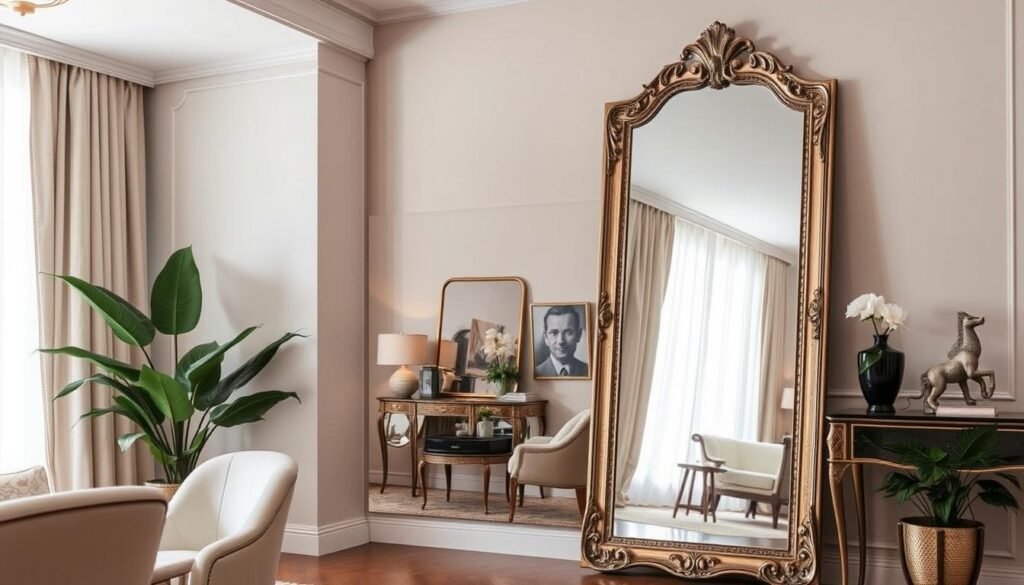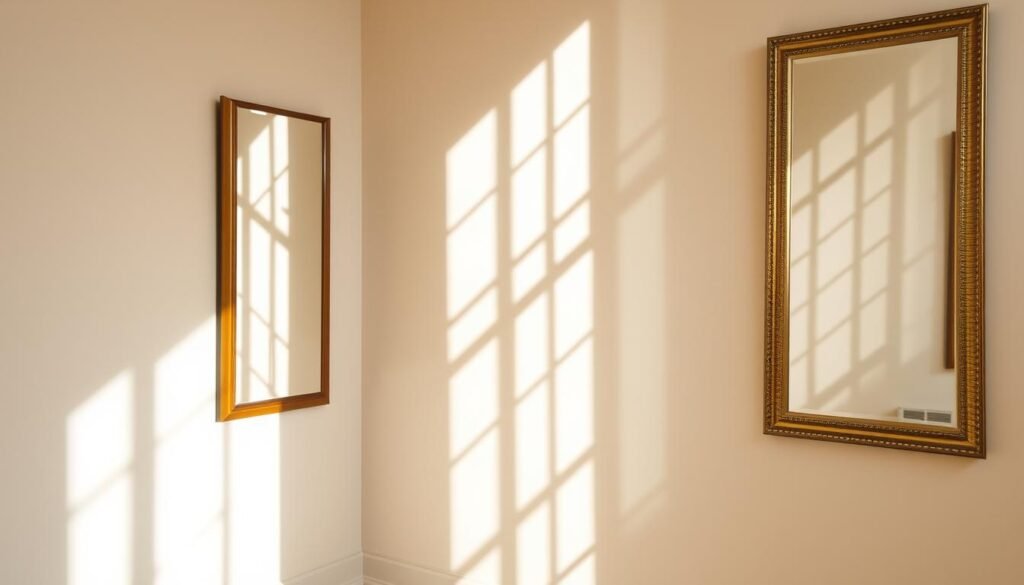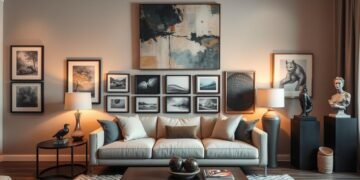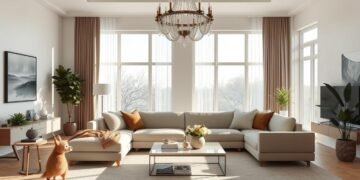When you enter your home, you notice the magic of light and reflection. This is thanks to mirrors placed thoughtfully. They can change how a room feels, making it seem deeper, brighter, and more balanced. In this guide, we’ll share 8 tips to use mirrors to improve your space’s look and feel.
Table of Contents
- 1 Understanding Mirror Placement Fundamentals
- 2 Maximizing Light with Strategic Mirror Positioning
- 3 Using Mirrors for Proportion
- 4 Mirrors as Architectural Elements
- 5 Creating Focal Points with Decorative Mirrors
- 6 Enhancing Small Spaces with Mirror Design
- 7 Mirror Types and Their Specific Applications
- 8 Incorporating Mirrored Furniture
- 9 Light Distribution and Reflection Techniques
- 10 Style Integration and Design Harmony
- 11 Conclusion
- 12 FAQ
- 12.1 How can mirrors enhance proportion and focus in interior design?
- 12.2 What are the principles of strategic mirror positioning?
- 12.3 How does mirror size affect room balance?
- 12.4 What is the role of natural light in mirror placement?
- 12.5 How can mirrors be used as architectural elements?
- 12.6 How can decorative mirrors be used as focal points?
- 12.7 How can mirrors enhance small spaces?
- 12.8 What are the different types of mirrors and their specific applications?
- 12.9 How can mirrored furniture be incorporated into interior design?
- 12.10 How can mirrors be used to distribute light evenly throughout a room?
- 12.11 How can mirrors be integrated into different design styles?
- 13 Source Links
Key Takeaways
- Mirrors can make a room look better, balance it out, and change how we see the space.
- Choosing the right mirror size and where to put it is key to its impact.
- Mirrors can reflect natural light, making a room feel brighter.
- Decorative mirrors can be eye-catching, creating focal points in a room.
- Using mirrors can make a room seem bigger and more open.
Understanding Mirror Placement Fundamentals
Strategic mirror placement is key to making any room look better. The size and where you put the mirror greatly affect a room’s balance and flow. It’s important to think about how the mirror size relates to the viewer’s height.
A study found that a person needs a mirror that’s half their height to see themselves fully. For instance, a 6-foot tall person needs about 3 feet of mirror. This 1:2 ratio is seen in physics labs and mirror studies.
Principles of Strategic Mirror Positioning
The size of the mirror should match the furniture or architectural features it’s above. If the mirror is too small or too big, it can mess up the room’s look. Also, how far you stand from the mirror doesn’t change how much mirror you need to see yourself, thanks to the laws of optics.
Role of Natural Light in Mirror Placement
Reflecting natural light with mirrors is a smart design trick. It can make a room look brighter and bigger. Mirrors placed opposite windows or light sources can spread light around the room, making it feel more open and welcoming. This trick is great for rooms with little natural light, as it makes them seem larger and brighter.
By grasping the basics of mirror placement, people can make spaces that are both beautiful and useful. Mirrors are powerful tools in design, and knowing how to use them can greatly enhance any room.
Maximizing Light with Strategic Mirror Positioning
Mirrors can change how a room feels and looks. By placing mirrors right, you can make rooms seem bigger and brighter. Let’s see how mirrors can light up your home.
Putting mirrors opposite windows is smart. It reflects sunlight and brightens the room. This trick can make a room feel more open and welcoming. Mirrors near entryways are great for quick looks and a warm welcome.
Mirrors above furniture, like mantels, add depth and balance. In hallways, they make the space seem larger and brighter. Dining areas benefit from mirrors, reflecting light and creating a cozy feel.
Size and placement matter for mirrors. Custom mirrors fit spaces perfectly, reflecting light well. Wood-framed mirrors warm up traditional homes, while metallic ones suit modern styles.
Mirrored accent walls are striking. They reflect light from all sides, brightening a room. Gold mirrors can turn dark areas into bright spots with their warm glow.
“Mirrors have the power to make a space feel larger, brighter, and more inviting. By strategically positioning them, you can truly harness the magic of light reflection to transform the ambiance of any room.”
Mirrors work with both natural and artificial light. Try different sizes and places to find the best mirror setup for your home. It will make your space lively and inviting.
Using Mirrors for Proportion
Mirrors can greatly improve a room’s look by balancing its proportions. The size and where you put mirrors are key to a nice, balanced space. Learning about mirror design can help make your room look better.
Creating Visual Balance with Mirror Sizes
The mirror’s size should match the furniture or wall it’s on. A good rule is to pick a mirror that’s as wide as or a bit wider than the furniture. This keeps the mirror from looking too big or out of place. In bathrooms, mirrors should be a bit narrower than the vanity for a neat look.
Symmetrical vs. Asymmetrical Arrangements
There are two main ways to place mirrors: symmetrical or asymmetrical. Symmetrical mirrors, like two on either side of something, bring order. Asymmetrical mirrors, with different sizes or shapes, add interest and a lively feel.
Distance and Height Considerations
The mirror’s height and how far it is from you matter a lot. Taller mirrors should be placed so they’re seen comfortably from all angles. Think about how close the mirror is to you and other things in the room to keep everything looking good together.
Knowing how to use mirrors can make your space look better. Try different sizes, arrangements, and places to find the best fit for your room. This will help your mirrors add to your room’s beauty.
Mirrors as Architectural Elements
Mirrors are more than just household items. They can add depth, interest, and openness to any space. By using mirrors as design elements, you can make rooms feel bigger and brighter.
Installing mirrored wall panels is a creative way to use mirrors. They can fit into alcoves, entryways, or even kitchen backsplashes. This adds elegance and visual interest. The reflected light makes small spaces feel larger.
Mirrors can also be used to improve room flow. Place them opposite windows or in built-in features like shelves. This lets natural light spread, making rooms feel bright and airy.
Mirrors have a long history, starting with ancient civilizations like Mesopotamia. They used polished copper to make the first mirrors around 6000 BC. The Romans later used glass, and France made big strides in the 17th century.
In India, mirrors have a special place in architecture and art. The Sheesh Mahal in Rajasthan has thousands of small, hand-cut mirrors. They create a stunning, kaleidoscope-like effect.
Today, mirrors are loved by designers and homeowners. They help maximize natural light, create space, and add elegance. Using mirrors can change the look and feel of any room.
Creating Focal Points with Decorative Mirrors
Mirrors can be more than just functional in your home. They can be stunning focal points that make any space look better. By picking the right decorative mirrors and where to put them, you can create eye-catching moments. These moments can draw the eye and make the room feel more welcoming.
Statement Mirror Selection
The frame style of a mirror is very important for creating a focal point. Look for framed mirrors with unique, eye-catching designs. For example, sunburst mirrors add elegance, while large, ornate mirrors above fireplaces or entryways can make a big impact.
Frame Styles and Their Impact
The frame of a mirror greatly affects how it looks. Choose gilded, ornate frames for a luxurious, traditional look. Or, go for sleek, minimalist frames for a modern, accent mirrors feel. The frame should match the room’s decor and architecture.
Positioning for Maximum Effect
Where you place your mirrors is very important. Put your art deco mirrors or minimalist mirror designs to reflect interesting views, artwork, or natural light. This creates a beautiful play of light and depth. Mirrors can also make small rooms look bigger, which is great for tight spaces.
“Mirrors have the power to transform a space, adding depth, light, and a touch of elegance. By using them as focal points, you can elevate the overall design and create a truly captivating atmosphere.”
Enhancing Small Spaces with Mirror Design
Mirrors can change how small spaces look and feel. They reflect light and make rooms seem bigger. By using mirrors wisely, you can make tight areas feel more open and airy.
One smart move is to put a big mirror opposite a window. This trick makes the room brighter and more spacious. Mirrors near doors or entryways also make rooms feel more open.
Bigger mirrors have a bigger impact on small rooms. It’s important to match the mirror’s size to the wall or furniture. Frameless mirrors work best because they blend into the wall, making spaces feel even bigger.
Mirrors with special features, like beveled edges or patterns, add interest to small areas. These details highlight your home’s design and create a focal point.
For small spaces, think about mirrored cabinets or wall-mounted mirrors with shelves. These offer storage and make rooms seem larger and more open.
“Properly sizing mirrors according to the wall or furniture they are placed on helps create a balanced effect.”
Understanding mirror design and using them smartly can change small spaces. Mirrors can make your living area look bigger and more welcoming. Let mirrors help you create a beautiful and expansive space.
Mirror Types and Their Specific Applications
Mirrors are key in making any space look better and work better. Full-length mirrors make rooms seem bigger and brighter. Decorative mirrors add elegance. Each type of mirror has its own role.
Let’s look at the different mirrors and how they can improve your home.
Full-Length Mirrors
Full-length mirrors are great for making rooms feel larger and brighter. They work well in living rooms and master suites. These mirrors reflect light, making the room feel more open.
They’re perfect for small spaces. The light and depth they add can make a room seem bigger.
Wall Panels and Custom Installations
Wall panels and custom mirror installations can make a big statement. They blend seamlessly into the design, highlighting special features. Custom mirrors can turn any room into a work of art.
They offer endless ways to enhance your space’s look.
Decorative and Accent Mirrors
Decorative and accent mirrors come in many shapes and styles. They add personality and style to any room. Whether it’s a big mirror over a fireplace or a small one in a powder room, they make a statement.
The right mirror can become the room’s focal point. It catches the eye and leaves a lasting impression.
Mirrors are versatile and can improve your home in many ways. They can make rooms look better, create focal points, and spread light. By choosing the right mirror for your space, you can change its look and feel.
Incorporating Mirrored Furniture
Mirrored furniture can change how your living spaces look and feel. These reflective pieces make rooms seem bigger and brighter. They are great for adding both style and function to your home.
Mirrored sideboards, bed frames, and tables add glamour to any room. But, use them sparingly to avoid clutter. Choose designs with fretwork or overlays to hide marks and add interest.
Mirrors are more than just decor; they’re practical too. Placing them right can spread light, making rooms seem larger and brighter. This is perfect for small or dark spaces, where mirrors can reflect light and cut down on the need for extra lamps.
Think about your room’s style when adding mirrored furniture. Make sure the furniture fits with your decor. This way, you can make your space look better and more balanced.
| Mirrored Furniture Trends | Benefits of Mirrored Furniture |
|---|---|
|
|
Adding mirrored furniture and decor can make your space look better and work better. Use these pieces wisely to enhance your home’s look and feel. They should stand out as key elements that match your home’s style.
“Mirrors have the power to transform a room, making it appear larger, brighter, and more visually captivating.”
Exploring mirrored furniture and decor means understanding design, placement, and light. By getting these right, you can create a beautiful and functional space that shows off your taste and style.
Light Distribution and Reflection Techniques
Mirrors can greatly improve the lighting in your space. By placing mirrors in strategic spots, you can spread natural light and make your area look better. A good trick is to put mirrors opposite windows. This way, they reflect and boost the natural light coming in.
Using mirrors with frames that reflect light can make a bigger difference. These frames add to the light bouncing off the mirror. Try out different shapes and sizes of mirrors to create interesting light effects and add visual appeal to your room.
Mirrors can also make a room seem bigger and more open. By arranging mirrors right, you can change how light and shadow look. This creates a cool optical illusion.
| Light Source Type | Description |
|---|---|
| Ambient Light | Evenly distributed light that does not have a specific direction. |
| Point Source | Light that emits equally in all directions, with intensity decreasing with the square of the distance. |
| Distant Light | Light source where the intensity does not vary with distance, making all distances equal. |
| Spotlight | Complex light source defined by a cone angle and intensity determined by the cosine of the angle. |
Knowing about different light sources and how they work with mirrors is key. Mirrors can change the look and feel of any space. They can make your home or business look better and feel more welcoming.
The mirrors used in this study are special. They can control light in new ways. These mirrors could lead to cool effects like lasers and even help in quantum physics.
“Investigations of synthetic frequency dimensions on photonic chips have not been extensively studied, with few exceptions.”
The study of reflecting natural light with mirrors, optical illusion with mirrors, and lighting and mirrors is growing. The new ideas in this research could open up exciting ways to work with light.
Style Integration and Design Harmony
Mirrors can fit into many design styles, from modern to classic. They can make your space look beautiful and balanced. By knowing how to use mirrors, you can make your home look better and work better.
Contemporary Mirror Applications
In modern spaces, choose sleek, frameless mirrors or ones with simple shapes. These designs match the clean look of modern decor. They add a touch of elegance without being too bold.
Placing these mirrors right can make your room feel bigger and brighter. It’s all about creating a sense of openness.
Traditional Mirror Placement
In traditional rooms, go for mirrors with fancy frames. Frames with detailed carvings or gold accents add to the room’s classic feel. Where you put them matters a lot.
Traditional mirrors look best above fireplaces, consoles, or built-in shelves. They become a key feature in the room.
Mixed-Style Approaches
Mixing modern and classic mirrors can make your space interesting and unique. Pair a simple, modern mirror with an ornate, old-style one. This mix adds depth and shows off your personal taste.
Getting design harmony is all about knowing how to use mirrors. Think about your space’s look and choose mirrors that fit and enhance it. This way, you can make your home look great, no matter your style.
Conclusion
Mirrors are powerful tools that can greatly improve the look and feel of a room. By placing mirrors wisely, you can make spaces look bigger and more open. They also help distribute light better, making rooms brighter.
When using mirrors, think about how they can balance your space. They can draw attention to certain areas or make rooms feel larger. By understanding how mirrors work, you can use them to create amazing looks.
Keep in mind the importance of mirrors as you decorate. Remember to use mirrors for proportion, mirror techniques, and to enhance spatial awareness. These ideas will help you make your mirror choices work well with your space’s look and feel.
FAQ
How can mirrors enhance proportion and focus in interior design?
What are the principles of strategic mirror positioning?
How does mirror size affect room balance?
What is the role of natural light in mirror placement?
How can mirrors be used as architectural elements?
How can decorative mirrors be used as focal points?
How can mirrors enhance small spaces?
What are the different types of mirrors and their specific applications?
How can mirrored furniture be incorporated into interior design?
How can mirrors be used to distribute light evenly throughout a room?
How can mirrors be integrated into different design styles?
Source Links
- Everything You Need to Know to Choose the Best Mirror
- Essential Tips for Selecting the Perfect Mirror – Splendid Window Glass Repairs
- Bathroom Mirror Tips to Help Transform Your Bathroom
- What Portion of a Mirror is Required to View an Image?
- Mirrors: A Powerful Addition to Your Space
- 5 Strategic Places to Hang Mirrors to Enhance Natural Light at Home
- Enhancing Natural Light: How Custom Mirrors Brighten Any Room
- Maximizing Natural Light with Gold Mirrors: Tips and Tricks –
- How Tall is the Flagpole- Using mirrors to find Proportions CAMT 2019 – MathHappens
- Size Inflation in Drawing From Mirror and Proportional Accuracy in Observational Drawing – PubMed
- Illusion of Space: How to Use Mirrors in Interior Design
- The Role of Mirrors in Interior Design
- Decorating with Mirrors: Expanding Space – The Great Frame Up :: Littleton
- Decorating with mirrors – ideas and rules for how to use mirrors in your home
- Using Mirrors to Make Small Spaces Feel Larger
- Brighten Up Your Living Space With Mirrors
- 11 Ways to Use Mirrors to Make Your Space Look Bigger
- Home Mirror Types | How to Use Them Efficiently
- Basic Properties of Mirrors – Introduction to Mirrors
- Concave Mirrors And Convex Mirrors – Image Formation, Ray Diagram
- Maximizing Your Home’s Style With Mirrors
- Illusion of Space: How to Use Mirrors in Interior Design
- Mirror-induced reflection in the frequency domain
- Microsoft PowerPoint – 07-lighting.ppt
- The 7 Basic Principles of Interior Design | Kathryn Interiors | Interior Design
- The basic principles of design—and how to apply them
- 7 Core Principles of Interior Design
- How Diffusers, Proportions, and Mirrors Work Together to Create Beautiful Lighting Effects
- A Study on the Role of Mirrors in Everyday Life
